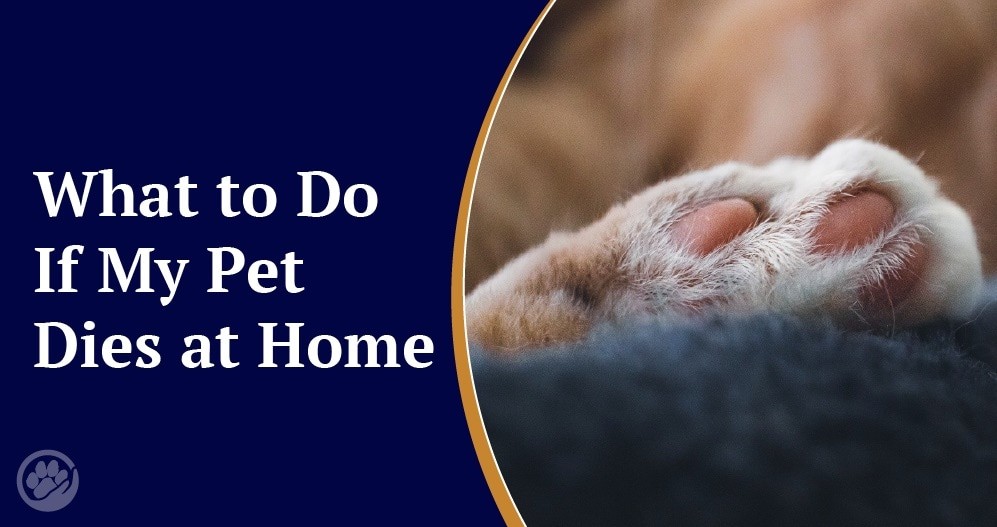Losing a beloved pet is an incredibly painful experience. As cherished members of our families, their passing leaves a void that is deeply felt. While we often envision saying goodbye at a veterinary clinic, sometimes our pets pass away peacefully in the familiar comfort of our homes. Knowing what to do when your pet dies at home can provide a sense of control and peace during a difficult time, allowing you to honor your pet’s memory with care and respect. This guide offers compassionate steps to take when facing this heartbreaking situation.
Confirming That Your Pet Has Passed Away
Before making any decisions, it’s essential to ensure your pet has indeed passed. Especially with older or ill pets, they may exhibit shallow breathing, remain still, or sleep for extended periods, mimicking the appearance of death. Carefully check for vital signs to be certain.
To confirm your pet has passed:
- Check for a Pulse: Gently place your fingers on the inside of their thigh, near the upper leg, to feel for a heartbeat. If you are unsure, try feeling for a pulse near their elbow joint.
- Listen for Breathing: Observe their chest for any rise and fall, and listen closely for breaths near their nose and mouth. Shallow breathing can be very faint, so listen attentively for a few minutes.
- Check for Responsiveness: Gently touch their eye or whisker to see if there is any reaction. However, be aware that in the immediate moments after death, there might be some muscle twitching or reflexes, but these are involuntary and not signs of life.
If you are uncertain, it is always best to contact your veterinarian for guidance.
Contacting Your Veterinarian or Emergency Vet Clinic
Once you have confirmed your pet has passed, take a moment to compose yourself and then contact your veterinarian. Even if your pet has died at home, your vet’s office is a valuable resource. They can provide support, guidance on the next steps, and answer any questions you may have regarding pet aftercare.
If your regular veterinary clinic is closed, or if you do not have an established veterinarian, contact the nearest emergency animal clinic. Emergency vets are accustomed to handling sensitive situations and can offer immediate advice and assistance. They can also help connect you with pet cremation or burial services if needed. Having professional guidance during this emotional time can be incredibly helpful and relieve some of the burden of decision-making.
Understanding Your Options for Handling Your Pet’s Remains
One of the first questions you may face, either from your veterinarian or yourself, is what to do with your pet’s remains. It’s helpful to be aware of the options available to make an informed decision that feels right for you and honors your pet. Common options include:
- Home Burial: Depending on local regulations and ordinances, you may be permitted to bury your pet in your backyard. Check local laws regarding pet burial depth and any restrictions. Ensure the burial location is away from water sources and consider placing your pet in a biodegradable container.
- Pet Cemetery Burial: Pet cemeteries offer a dedicated and often beautifully maintained final resting place for your pet. This option provides a permanent memorial site you can visit. Pet cemeteries usually offer various burial options, including plots and memorial markers.
- Pet Cremation: Cremation is a popular choice and offers several options:
- Private Cremation: Your pet is cremated individually, and their ashes are returned to you in an urn of your choosing. This ensures you receive only your pet’s ashes.
- Communal Cremation: Multiple pets are cremated together, and the ashes are not returned to the owners. This is generally a more economical option.
- Witnessed Cremation: Some cremation services offer the option to witness the cremation process, providing a sense of closure for some pet owners.
Your veterinarian can often facilitate contact with reputable pet cremation or burial services in your area, simplifying the process during a difficult time.
 Comforting a dog, a loving bond during pet loss
Comforting a dog, a loving bond during pet loss
Considering Pet Cremation Services
If you are considering cremation for your pet, you can directly contact pet cremation services in your area. These specialized services focus on providing respectful and compassionate aftercare for pets. They can arrange for the dignified transport of your pet from your home or veterinarian’s office.
When choosing a cremation service, consider:
- Reputation and Reviews: Look for services with positive reviews and testimonials from other pet owners, indicating trustworthiness and compassionate care.
- Range of Services: Check if they offer different cremation options (private, communal, witnessed) and memorial products.
- Transparency and Process: A reputable service will be transparent about their processes and answer your questions with sensitivity and clarity.
Contacting a pet cremation service directly can provide you with detailed information about their procedures and help you make arrangements that suit your needs and preferences.
Preparing Your Pet’s Body with Care
After your pet has passed, some natural physical changes will occur. As muscles relax, there might be involuntary release of bodily fluids. Taking a few simple steps can help maintain your pet’s dignity and make handling their body easier.
- Place on a Towel or Blanket: Gently move your pet onto a soft towel or blanket. This will provide a comfortable surface and help protect your flooring from any fluids that may be released.
- Move to a Cool Location: If possible, move your pet to a cooler area of your home, such as a garage or basement, especially if the weather is warm. A cool environment helps slow down natural decomposition processes.
- Position Your Pet: If you plan to transport your pet or if rigor mortis (stiffening of muscles) has not yet set in (typically within a few hours), you can gently position your pet in a natural, comfortable resting position. This can make handling and transportation easier later.
These steps are acts of care and respect for your pet in their final moments.
Allowing Other Pets to Say Goodbye
If you have other pets in the household, consider allowing them to see and sniff your deceased pet’s body. While it may seem difficult, this can be a helpful step in their grieving process. Animals understand more than we sometimes realize, and allowing them to acknowledge the passing of their companion can help them understand the change in their environment and begin to adjust. Supervise these interactions and allow your living pets to approach at their own pace.
Keeping Your Pet Cool Until Arrangements are Made
Whether you are waiting for a cremation service to collect your pet or preparing to take them to the veterinarian, keeping their body cool is advisable, especially if there will be a delay.
- Wrap in Plastic Bags (Optional): To further protect against leakage and odor, you can gently wrap your pet in plastic bags, like heavy-duty garbage bags.
- Store in a Cool, Dry Place: The coolest, driest place available, such as a garage, basement, or utility room, is suitable for temporary storage.
These measures are temporary and designed to maintain your pet’s body respectfully until final arrangements are made.
Memorializing Your Beloved Companion
After the immediate arrangements are made, you may want to consider ways to memorialize your pet and celebrate their life. Memorializing your pet is a deeply personal process and can be an important part of healing.
Ideas for memorializing your pet include:
- Cremation Urn: If you choose cremation, selecting a beautiful urn to hold your pet’s ashes can be a lasting tribute.
- Paw Print Keepsake: Many veterinary clinics or cremation services offer paw print keepsakes, capturing a tangible reminder of your pet. You can also create your own paw print using non-toxic ink or clay.
- Photo Album or Scrapbook: Gather photos and memories of your pet to create a special album or scrapbook celebrating their life.
- Memorial Garden: Plant a tree, flowers, or create a dedicated garden space in your yard in memory of your pet.
- Donation in Their Name: Making a donation to an animal charity or shelter in your pet’s name is a meaningful way to honor their memory and help other animals.
Choose a memorial that resonates with you and brings you comfort as you remember your beloved pet.
Allowing Yourself to Grieve and Seek Support
The loss of a pet is a significant emotional event. Allow yourself time to grieve and process your emotions. There is no right or wrong way to grieve, and everyone experiences loss differently.
- Acknowledge Your Feelings: Don’t suppress your sadness, grief, or any other emotions you are feeling. Allow yourself to cry, reminisce, and feel the pain of your loss.
- Talk to Someone: Share your feelings with friends, family members, or other pet lovers who understand the bond you shared with your pet.
- Consider a Support Group or Counselor: If you are struggling with intense grief, consider seeking support from a pet loss support group or a grief counselor. These resources provide a safe space to share your feelings and learn coping strategies.
- Be Patient with Yourself: Grief takes time. Be patient with yourself as you navigate this process, and allow yourself to heal at your own pace.
Remember, the love you shared with your pet was profound and meaningful. Honoring their memory and allowing yourself to grieve are essential steps in healing and moving forward with love and remembrance.
